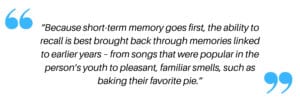Lillian, formerly an opera singer and today a resident living with Alzheimer’s Disease and Related Dementias, likes to sing loudly. It’s her way of communicating. But it can be disruptive. To help her focus on other activities that feel familiar, staff in the community where she lives put together a “life engagement kit.”
“We filled the kit with tools and resources to use when Lillian is singing or calling out,” says Susan McKinney, vice president of operations at Lifetime Wellness, a certified dementia practitioner and trainer, and a recreational therapist. Inside the personalized toolkit are a variety of engaging items: for example, an iPod loaded with Lillian’s favorite songs; lollipops and peppermint gum, to stimulate her taste buds; and a baby doll, “because she’s always been a nurturer,” McKinney says.
Lifetime Wellness provides person-centered wellness, life enrichment, and recreational programming to assisted living, skilled nursing and rehabilitation, and memory care facilities throughout Texas and Oklahoma. A key offering is memory activation and engagement activities that help residents with Alzheimer’s disease remember and reconnect.
“For people living with Alzheimer’s disease and related dementias (ADRD), memories often reawaken with a prompt from the past,” McKinney says. “Because short-term memory goes first, the ability to recall is best brought back through memories linked to earlier years – from songs that were popular in the person’s youth to pleasant, familiar smells, such as baking their favorite pie.”
Creating the Life Story

“We start with the person’s life story, using a structured method for gathering information about their life,” McKinney says. “Key points are distributed to all caregivers so we’re aligned in our approach.”
Information is gathered from the residents themselves and from their family members. It’s condensed into a one-page summary that is placed by the bedside so staff can readily learn about each resident in their care. Or it may be expanded into a life scrapbook that provides a meaningful reference for staff and families alike.
“It’s important for families of a loved one receiving an ADRD diagnosis to start compiling information early on. As the disease progresses, it will be more and more difficult for their loved one to share information. We encourage families to capture these memories at the onset.”
Discover how partnering with Lifetime Wellness can improve the quality of care for seniors.
Celebrating the Life Journey
“For people living with ADRD, every life journey is different,” McKinney says. “Our goal is to support memory care residents through every step of their experience – and walk the journey with them.”
The key is discovering what activities are most meaningful to the individual. Often, meaning is tied to a past career, hobby, or passion. For example, for a career homemaker, an invitation to dust dressers or set the table may be helpful. Someone who liked to build things may enjoy playing with an old-time erector set. A former teacher may reengage through classroom tools, such as pencils, flash cards, and a composition notebook. If the resident was once the CEO of a corporation, she may appreciate the opportunity to delegate responsibilities.
“Whatever the activity, the purpose is to give the person something familiar and meaningful to do,” McKinney says.
Life engagement kits can also help family members and other visitors connect with residents. “Sometimes families and friends don’t know how to reach their loved ones. Using these familiar objects – or looking through photos in the life scrapbook – can be the key to breaking through.”
Cultivating Nonpharma Approaches
Today, more than five million Americans are living with Alzheimer’s Disease and Related Dementias. By 2050, the number is projected to nearly triple. Leading-edge memory care providers are looking for alternatives to psychotropic medications in developing care plans.
“We’ve found nonpharmacological, person-centered approaches, such as our life engagement kits, often address behavioral responses more effectively than medications,” McKinney says. “Using these tools, staff and families can enter the reality of the resident – finding the best path to trigger memories, encourage interaction, and dramatically improve quality of life.